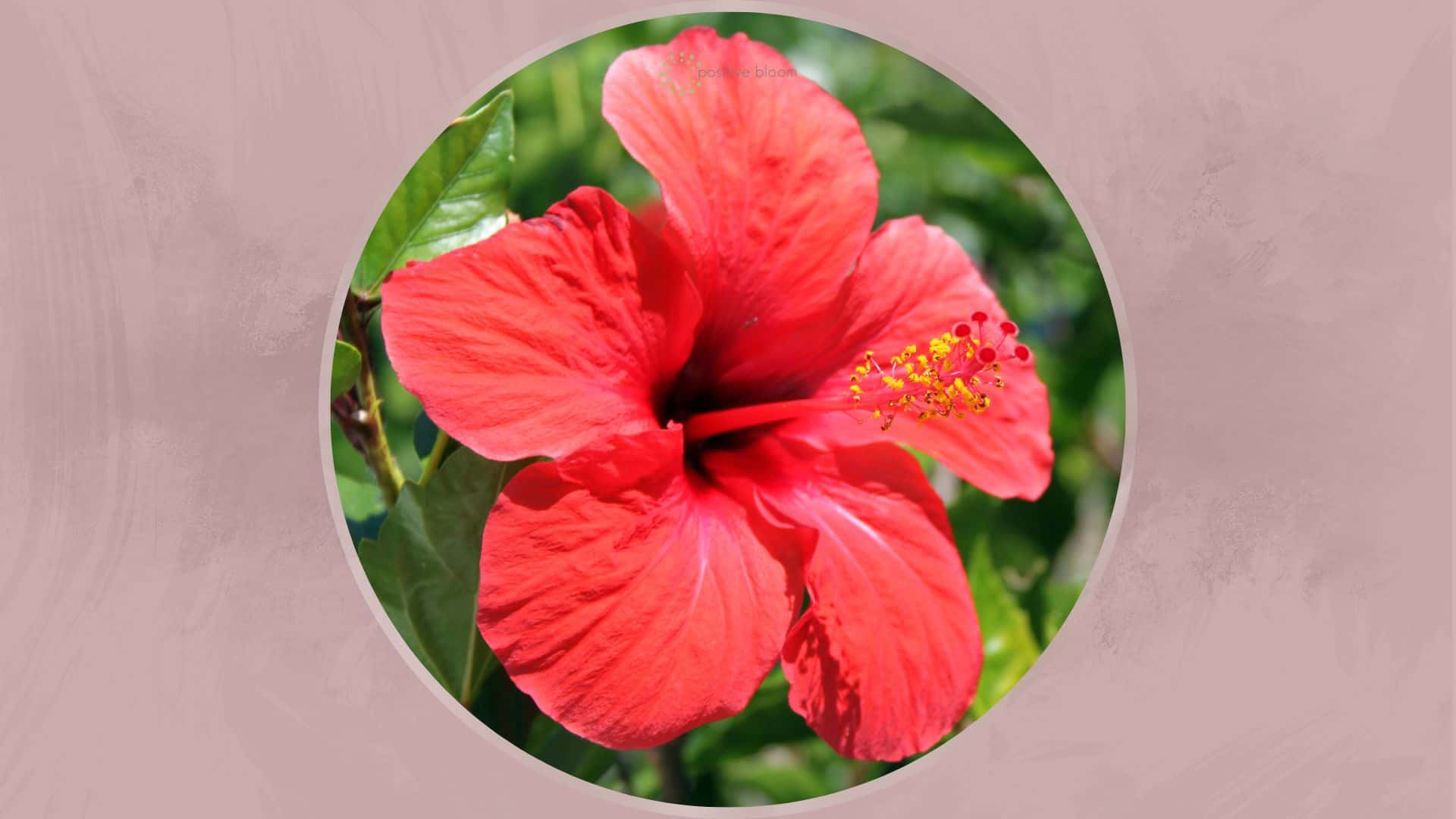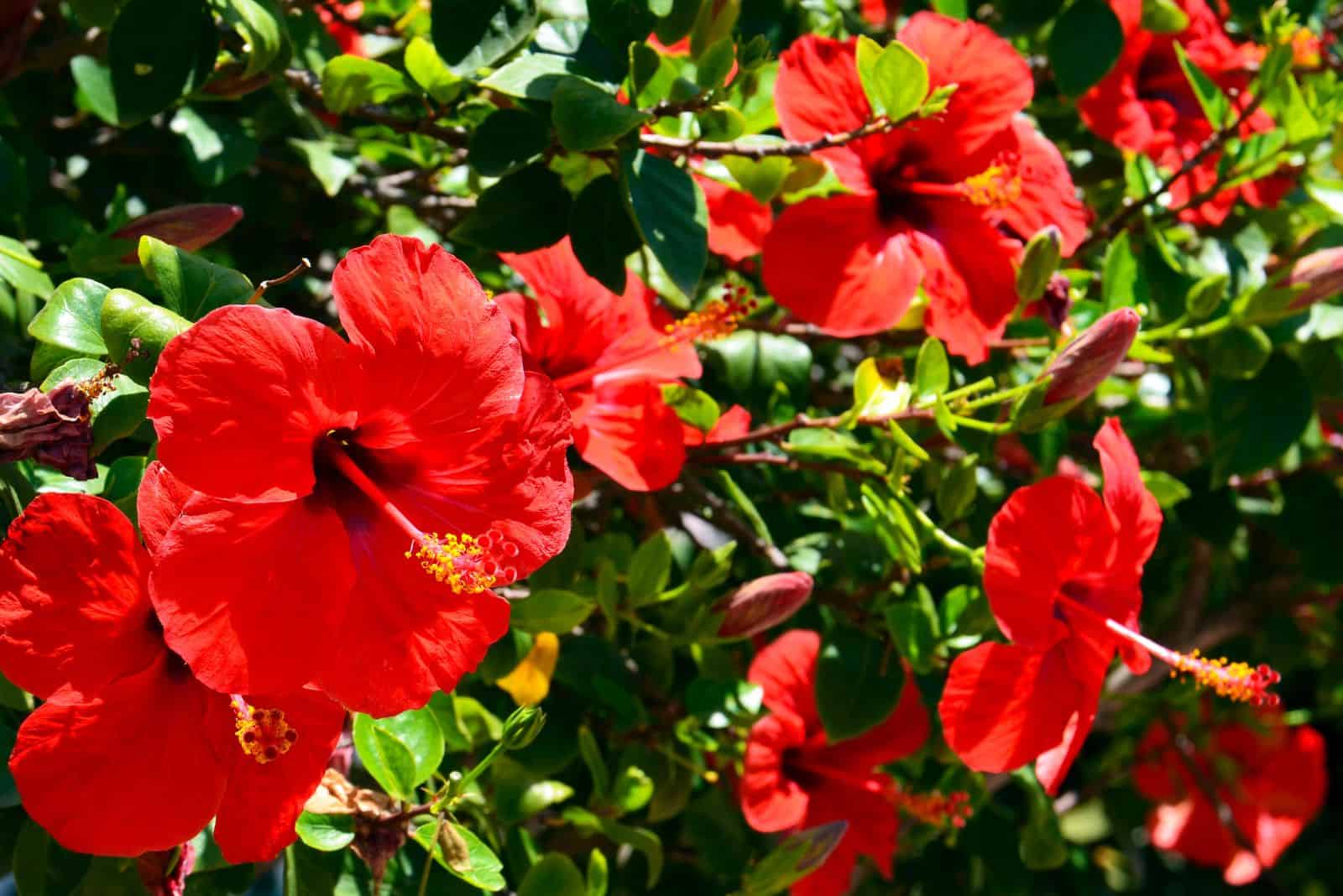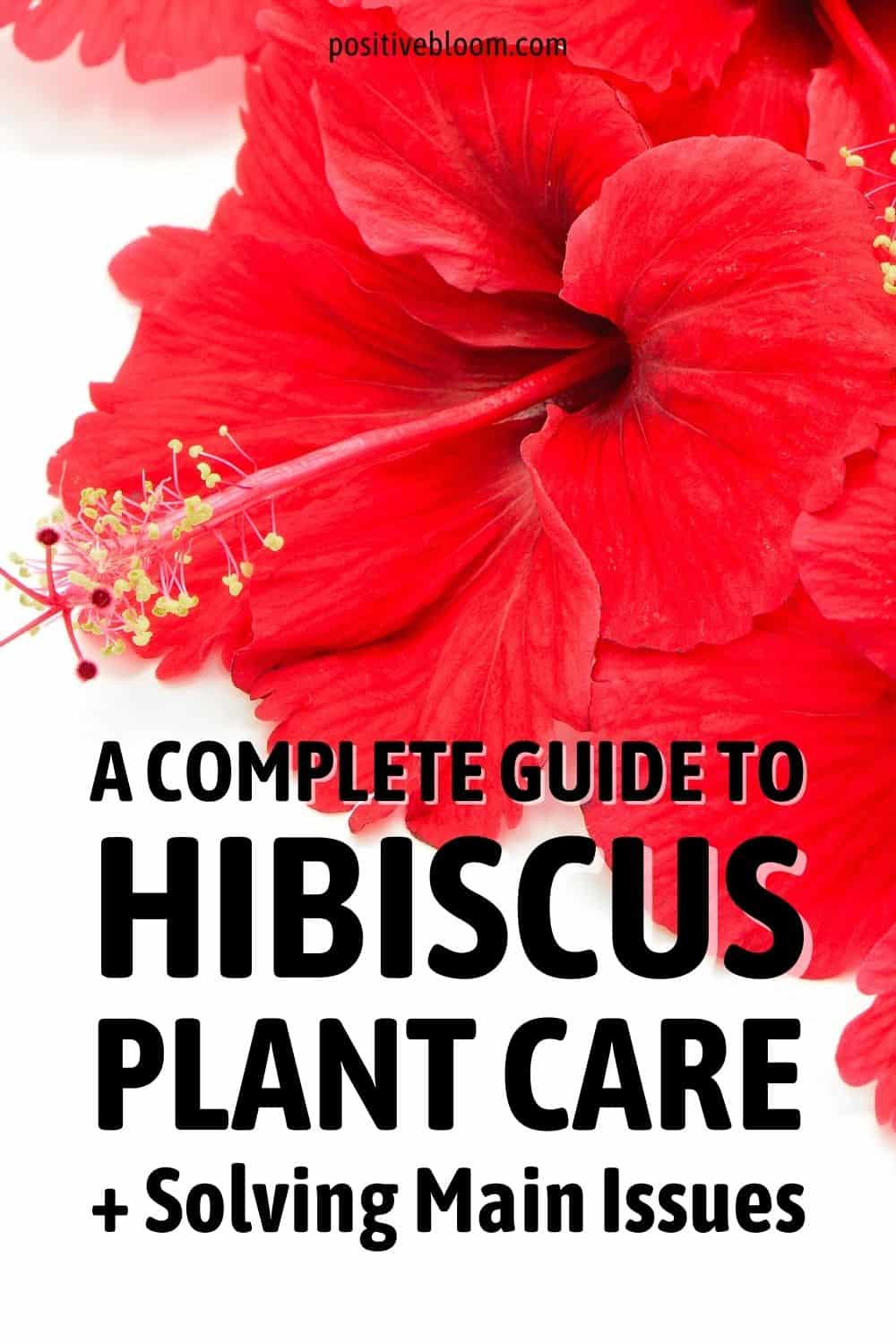Planting a hibiscus in your garden is an excellent way to ensure pollinators visit your plants. And if you have room in your yard, growing several shrubs or planting a hedge will have everyone talking!
We know that many beginners dread these undertakings, but hibiscus plants aren’t difficult to care for, and all you need is a bit of good will and patience to get them thriving.
Below, you can learn all the important details about caring for these perennial beauties, from their light, water, and soil requirements to propagating, transplanting, and pruning them.
We’ll also discuss some common issues these species can encounter so that you can get them over it in no time.
Finally, we decided to include some of the best types of hibiscus plants you can grow to make your yard shine and buzz with bees and hummingbirds!
Let’s dive right in!
Perennial Hibiscus Plant Care
Hibiscus plants require sunny locations and well-draining and moist soils for the best growth and abundant blossoms.
Of course, there are some other things you need to pay attention to, such as their preferred humidity, fertilization, and pruning.
And if you want to become a master gardener, knowing how and when to transplant and propagate these species can be a great bonus.
Finally, hummingbirds like hibiscus plants (as well as other pollinators), so you should care for these plants properly to reap all the benefits.
Light Requirements
All hibiscus varieties thrive in sunny locations and adore full sun conditions, especially if you grow them in cooler climates.
However, in the South, where temperatures are much higher, these plants benefit from partial shade, which protects their foliage from getting sunburned.
If you grow hibiscus plants indoors, place them on a sunny window where they will bask in the early morning or late afternoon sunlight.
And if the only available window is a west-facing one, you can always put up sheer curtains to filter the light and make it less harsh.
Don’t grow your hibiscus in low light because it’s one of the causes of non-blooming hibiscus.
Water And Humidity
Hibiscus plants love moisture, so you should water them regularly to keep the substrate moist. If you grow them in a container, always check the top few inches of the potting soil, and if they’re dry, you should irrigate your plant.
Pour water into the container and stop once you notice that it has started to run out through the drainage holes.
A Hibiscus in the garden requires less frequent watering, especially if you grow it in rainy regions or near bodies of water. Water in-ground hibiscus only if there hasn’t been any rain. Furthermore, if the temperatures are scorching, you might need to irrigate this plant every day.
But if the temperatures aren’t above 70°F, you shouldn’t water them daily since that may lead to overwatering and root rot. In these conditions, you should still irrigate them a couple of times a week because under-watering can also create various issues.
Finally, reduce the irrigation frequency in winter, when most hibiscus varieties enter dormancy.
Humidity
Hibiscus plants love high humidity, so you should always try to keep it between 50 and 70%. Growing this plant indoors makes it easier to maintain these levels because you can simply turn on a humidifier or mist the leaves occasionally.
You can also place your indoor hibiscus in more humid locations, such as kitchens or bathrooms if they have enough light.
Temperature
Growing hibiscus plants isn’t that difficult, especially if you’re in their preferred hardiness zone. Tropical hibiscus varieties thrive in temperatures between 60-85°F during the day, but can tolerate daytime temperatures as low as 50°F.
They can handle nighttime temperatures as low as 20°F, but that will stunt their growth if it’s for a prolonged period, so you should consider overwintering them inside.
Hardy varieties can handle much cooler temperatures and are grown in zones 5-8, where temperatures can get between -20 and -10°F. If you grow your hibiscus plants in containers, consider taking them inside during the winter period just to be on the safe side.
Soil And Fertilizer
Whether you have a red heart hibiscus, Rose of Sharon, or any other hibiscus variety, they all thrive in loamy, nutrient-rich, and well-drained soils with a slightly acidic pH level.
If your soil is too heavy and compact, you can amend it with some compost and humus, which will also introduce organic matter and make it more fertile. These materials increase moisture retention and drainage, making them perfect soil amendments.
If you’re growing a hibiscus as a houseplant, you can plant it in a high-quality potting mix with good aeration and moisture retention.
Fertilizer
The best fertilizer for most hibiscus plants contains high levels of nitrogen and potassium, such as Miracle-gro general-purpose 24-8-16 or Osmocotes 15-9-12.
A Hibiscus in the garden prefers slow-release fertilizer in late spring three times a year as soon as the new growth shoots out.
On the other hand, you should feed a potted hibiscus with a water-soluble liquid fertilizer diluted to at least half-strength twice a month during its growing season.
Some growers advise you to start feeding these plants once the first hibiscus blooms have faded.
But whatever you do, don’t fertilize them during dormancy, and always water them thoroughly after feeding them to make the nutrients available.
Propagation
You can propagate hibiscus plants from seeds and stem cuttings, and we’ll discuss both methods below.
This plant can also self-seed (especially the cranberry hibiscus), so you might not have to do anything in order to get a whole garden of these attractive shrubs. Propagating Hibiscus By Stem Cuttings
Step 1. Take some healthy cuttings and cut all the flower buds (if there are any) and the tip. You should also remove the bottom leaves since they can rot and contaminate the medium.
Step 2. Fill a nursery pot with a seed-starting mix (any soilless, well-draining medium will work), and plant your cuttings in it.
You can dip your cut stems in rooting hormone, but that’s not essential since this plant can root quite well on its own.
Step 3. Water the plants and place them in indirect light (or partial shade if you prefer leaving them outside).
Here you can find excellent advice that will help your multiply this plant from cuttings:
Grow Hibiscus Plants From Seeds
Propagating a hibiscus from seeds is a bit more challenging than using stem cuttings, but it’s doable.
Step 1. Chip the seeds a bit and soak them in lukewarm water for about 8 hours before planting.
Step 2. Plant them in a seed starting mix a quarter of an inch deep. Keep the growing substrate moist at all times. You can place a humidity dome or a plastic dome over it to keep the humidity levels high.
Step 3. Place the nursery tray in a bright and warm location where temperatures are around 70-75°F. You can place them on a heating mat to speed up germination.
Step 4. The seeds should germinate in about 2-3 weeks, but don’t transplant them just yet. Wait until they develop their second set of true leaves before moving them outdoors or into a larger planter.
Pro tip: Start your seeds 10-14 weeks before the last frost in spring so you can transplant young plants into your garden once the weather gets warm enough.
Here’s a great video that will help you get your seeds ready for germination:
How To Plant Hibiscus And Repot It
The care guide for a painted lady hibiscus (or any other variety for that matter) is clear on one thing: these plants need a permanent home, whether it is a 10-inch container or your garden.
The best time to transplant or repot hibiscus plants is in early spring because they’ll have more than enough time to acclimate to new conditions before the winter comes.
Before moving your hibiscus seedlings to the garden, you should harden them. Take them outside in a sheltered location and leave them there for a couple of hours before taking them back in. Repeat the process every day until the plants can last a whole day outside.
Then, dig a hole deep enough for the plant’s root system to fit, place the hibiscus in it, fill it with soil, and water your plant.
When repotting your hibiscus plants, take them out of their container and divide the roots if they’re root bound. Fill the new pot with fresh, fertile, and well-drained soil, place the plant in it, and cover its root system.
Water it until you see that moisture has started to drain out through the holes in the bottom.
Pruning
Cut back the hibiscus in late winter or early spring, just before the new growth starts to emerge. Remove all the dead and dry parts and shape the plant into the desired form.
You should also deadhead spent hibiscus flowers and remove all dead, dry, old, or diseased branches and leaves.
Just remember not to prune more than one-third of the plant, and you’ll be good to go!
Here are some more excellent tips for trimming hibiscus:
Common Issues In Hibiscus Care
The Hibiscus is an amazing plant as it is resistant to many pests and diseases. Of course, it can still get infected and infested, but not as much as some other outdoor or indoor plants.
Below, you can learn more about the common issues in hibiscus care, such as pest infestations and diseases, wilting, and yellowing of the leaves.
Pests
The most common pests that infest hibiscus plants are aphids, spider mites, and whiteflies. These bugs suck the sap from your plant and can cause severe damage if you don’t deal with them at once.
As soon as you notice an infestation, separate your afflicted hibiscus from other plants, and use neem oil or insecticidal soaps to deal with pests.
You can also pick them off one by one or use a cotton swab dipped in alcohol if the infestation isn’t heavy.
Diseases
There are a couple of common hibiscus diseases that afflict these plants, but the prevailing ones are root rot and leaf spot. Both occur as a result of inadequate moisture. Root rot is caused by overwatering, while leaf spot develops in warm and humid conditions.
Therefore, you can easily prevent them by maintaining the proper moisture levels in the soil and air around your plant.
However, if your plant still gets affected by these diseases, you can treat them. If you notice signs of root rot (yellowing of the foliage, stunted growth, wilting, unpleasant smell), you need to take the plant out of its planter, expose the roots, and remove the dark and mushy ones.
Then, spray your plant with a fungicide, and pot it in fresh soil and a clean planter.
If your plant is infected with leaf spot, you should prune any heavily diseased foliage and spray everything else with fungicide.
Wilting
The main reason your hibiscus is wilting is because it is underwatered or the temperatures are too high and moisture from the soil has quickly evaporated.
Simply water your plant, and it should perk up in no time.
However, your plant might also wilt because it has too much moisture in the soil or it suffers from root rot. In these cases, you should refrain from watering if the growing medium is wet and remove the diseased parts.
Yellow Leaves
The most common cause of yellow leaves in hibiscus plants is nutrient deficiency, lack of sunlight, or overwatering and root rot. You can avoid these issues by following the plant’s care guide.
Sometimes, the foliage can get a bit yellow in winter, so don’t jump to conclusions before checking all options.
Types Of Hibiscus
There are two main types of hibiscus plants – tropical and hardy varieties. Both categories have many beautiful species and cultivars, and below, we will discuss our favorites.
Tropical Hibiscus
Hibiscus rosa-sinensis – This type is characterized by unique shades of white, pink, apricot, yellow, orange, and red. There are many cultivars, such as ‘Cajun Cocktail’, ‘Brilliant’, ‘Red Dragon’, etc.
Hardy Hibiscus
Hibiscus moscheutos – This variety is also known as rose mallow hibiscus. Its flowers are usually white with a crimson center, but nature can surprise you sometimes and give you purely pink, white, or rose hibiscus blooms.
Hibiscus acetosella – The care guide for cranberry hibiscus is virtually the same as the care guide for all hibiscus plants, so growing it with other hardy varieties, such as Rose of Sharon, can make your work a lot easier.
Its leaves resemble Japanese maple, and the plant is entirely edible (flowers and leaves), which is why many growers opt for this variety.
FAQ
We discussed the most important facts regarding hibiscus, but there are still some questions left unanswered that we’d like to address in the paragraphs below.
How long do hibiscus plants live?
Older hibiscus varieties and cultivars can easily live to be 50 years old, while some modern types usually live between 5 and 10 years.
How do I keep my hibiscus blooming?
The best way to keep your hibiscus flowering is to deadhead spent blossoms, prune one-third of the plant in winter, and fertilize it during its growing season.
Blooms last only a day (although the flowers of some species can last for two days), but the plant will keep producing new ones, so don’t neglect it.
Final Thoughts
The main things you need to know about hibiscus plant care are to grow it in full sun (or partial shade if you live in hot regions), plant it in well-drained soil rich in organic matter, water it regularly, and fertilize it throughout its growing season.
You should also prune this plant in late winter or early spring and deadhead its withered blossoms so that it can produce new ones.
We also included tips for propagating and transplanting (repotting) it so that you can improve your gardening skills.
You also might encounter some common issues, such as dealing with pests, root rot and leaf spot, wilting, and yellow leaves, so we brought the causes of these problems and ways for treating them.
Finally, we described some cultivars you won’t be able to resist and which will tremendously decorate your yard (or indoor garden).
Like this post? Share or pin it for later!




